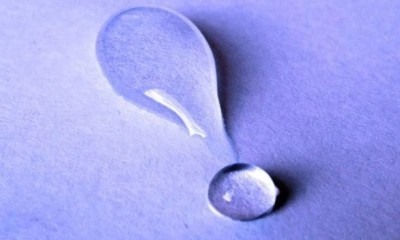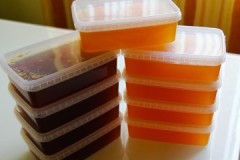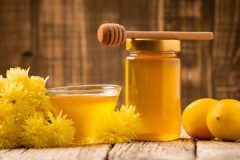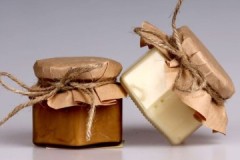Important recommendations on what temperature and other conditions honey should be stored at
 Honey, along with other beekeeping products, has a rich composition containing a large number of useful substances.
Honey, along with other beekeeping products, has a rich composition containing a large number of useful substances.
In order for it to retain the full range of beneficial properties throughout the entire period of use, it is necessary to comply with the conditions and terms of storage of honey.
Content
Storage according to GOST
Technical conditions for natural honey are regulated by GOST 19792-2017. This document specifies the composition of the product and the rules for its content. One of the main requirements is the need for protection from light.. When transporting, it is necessary to use a tarpaulin.
It is not allowed to store the product near dusty or toxic substances and mixtures that can affect the quality of honey. The shelf life of beekeeping products is determined by the manufacturer and indicated on the packaging.
House maintenance requirements
At home, it is also important to provide honey with optimal conditions for finding sweet reserves. This is necessary to preserve the taste and usefulness of the product.
Temperature indicators
 The air temperature in the place where honey is kept is one of the important indicators. To store flower nectar The best conditions are considered to be a temperature within 5-20°C.
The air temperature in the place where honey is kept is one of the important indicators. To store flower nectar The best conditions are considered to be a temperature within 5-20°C.
If there is any doubt about the high quality of the product, the temperature at the storage location should be up to +10°C. Under the same conditions, it is advisable to keep young, unripened honey containing a fairly high percentage of water.
In the freezer
According to accepted standards, it is not recommended to freeze honey, as this affects its structure. If a decision is made to freeze, it is necessary to ensure conditions under which the temperature does not fall below -15°C. This is due to the fact that When frozen below -20°C, the product may lose its beneficial substances.
When frozen, the honey mass will become very hard, but after thawing it will turn into the consistency of a thick syrup. Also, a thawed product almost always loses its ability to be sugared. Honey cannot be re-frozen.
Can it be kept warm?
Storing honey at temperatures above +20°C can harm the product. In a warm room it may begin to separate and change color. If, in addition, light falls on it, then fermentation may begin.
in winter
In winter, honey reserves must be stored so that they do not overheat or freeze. In a house or apartment, containers with nectar should be kept away not only from sunlight, but also from the heating system.
Lighting
Honey is not friendly with sunlight. One of the reasons for the product to separate into layers and change color may be exposure to sunlight.. If honey stands in the light for a long time, irreversible changes will begin to occur in it. Beneficial properties will also be lost, and even damage is possible.
Humidity
 For honey, it is preferable to keep it at low air humidity, up to 75%.
For honey, it is preferable to keep it at low air humidity, up to 75%.
If possible, it is better to create conditions with even lower humidity.
This is due to the ability of honey to absorb water. Wherein its quality will decrease and the likelihood of fermentation will increase and even complete damage.
Neighborhood with other products
Honey not only absorbs water well, but is also able to retain odors. Because of this feature, the product, even in a securely closed container, should not be kept near fish, pickles, smoked meats, etc.
Being in open and closed packaging
When storing honey, all requirements for its content must be observed. There is no particular difference in storage conditions between the contents of the product in open or closed containers.
If the honey product has already begun to be used, It is important to remember these simple rules:
- tightly close the container with flower nectar after use;
- do not use a metal spoon to scoop up the product;
- do not leave the spoon inside the vessel;
- do not use a dirty spoon to collect honey;
- prevent crumbs and other objects from getting inside the container;
- Do not transfer leftover honey reserves from different jars into one container.
The container should not be kept open for a number of reasons, including the possibility of dust and foreign objects getting into the product, and the honey absorbing foreign odors and moisture from the air.
What are the consequences of not following the rules?
 Honey, despite its long shelf life and not very demanding conditions, can deteriorate during storage.
Honey, despite its long shelf life and not very demanding conditions, can deteriorate during storage.
If the product is in the light, also warm, it heats up, separates, and can ferment.
High-quality honey contains a small percentage of moisture - no more than 20%. If the storage location is chosen with a high level of humidity, the product begins to absorb water. This has a detrimental effect on it and can provoke fermentation. Spoiled honey should not be used for food.
Conclusion
The rules for storing honey are not complicated; they can be followed even at home. This will allow beekeeping products to be preserved for many months.
But in case of violations nectar collected by bees can quickly become unusable – lose all its usefulness, aroma and appearance.


